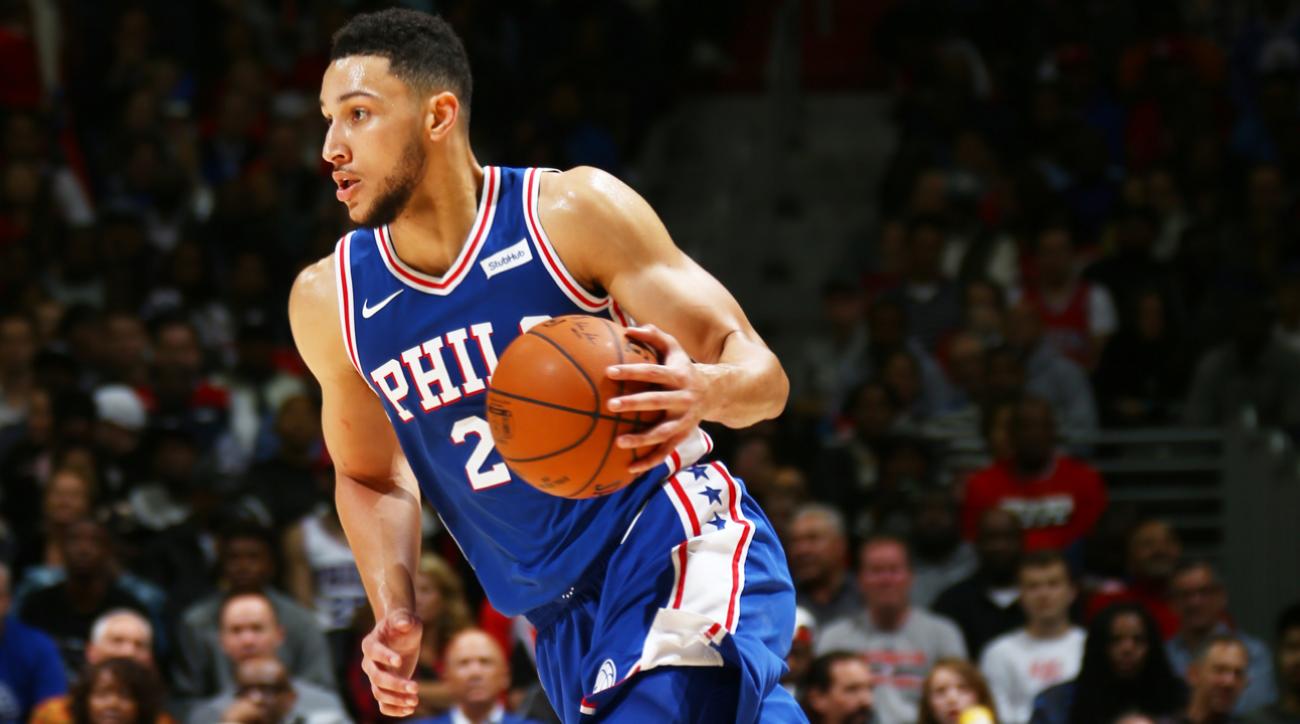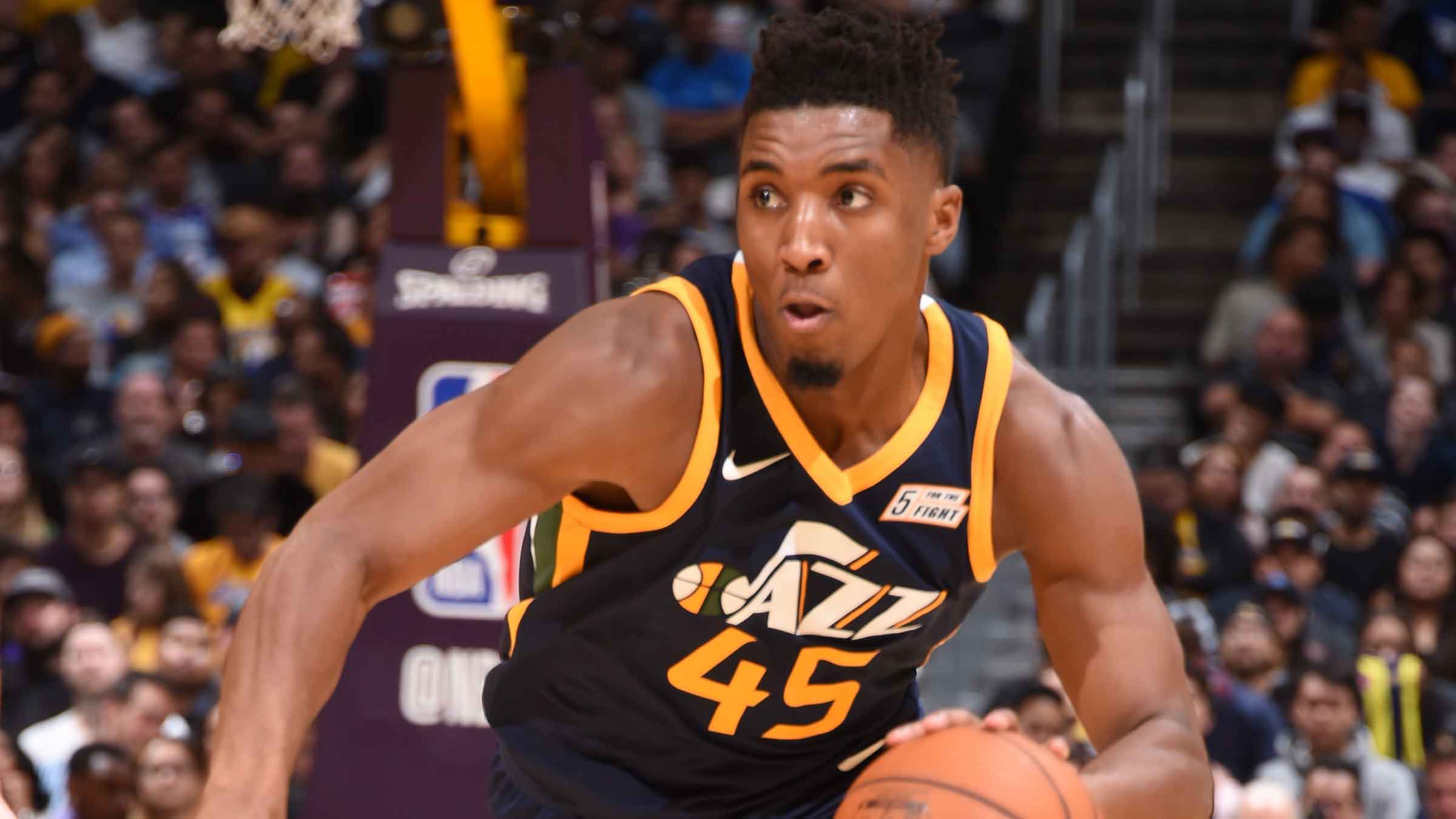
c/o NBA.com
Last June’s NBA draft wasn’t projected to be especially talented, and even with tempered expectations, many of the top picks have disappointed. First overall pick Markelle Fultz has been sidelined for months, while Lonzo Ball (second overall), Josh Jackson (fourth), De’Aaron Fox (fifth), and Jonathan Isaac (sixth) have done little to move the needle for bad teams. Yet despite the top-end disappointments, this year’s rookie class is shaping up to be one the deepest and most talented of the 2010s.
Though the field seems to have quickly narrowed into a two-man race, there are nearly a dozen players who—with all due respect to Malcolm Brogdon—could’ve made a legitimate case for last year’s award. Here are those rookies, and what’s made them so good.
10. Jarrett Allen, Center, Brooklyn Nets. Brooklyn was initially reluctant to give the 19-year-old a starter’s burn, but Allen has played his way into a key role for the surprisingly competent Nets. His initially limited minutes temper his counting stats, but his prorated numbers stack up favorably with any of the league’s young bigs. Allen was expected to be NBA-ready defensively, but offensively raw. He’s exceeded expectations in both categories. On defense, he’s anchored the Nets, possessing the size to body bigger centers and the agility to keep up with ball-handling bigs like fellow rookie Kyle Kuzma, whom he outdueled last week in Brooklyn. Offensively, Allen has no range, but has used his speed and creativity near the rim to reach double digits in his last eight games. He and Spencer Dinwiddie have become an effective odd-couple pick-and-roll duo, playing a huge part in propelling Brooklyn out of the NBA’s cellar. Allen clearly has room to grow, but he’s exceeded expectations and should see the court much more often going forward.
9. Bam Adebayo, Center, Miami Heat. With Kelly Olynyk sidelined, Miami is out of options to create frontcourt spacing next to Hassan Whiteside without sacrificing too much size. Enter Adebayo. What the University of Kentucky product lacks in shooting, he makes up for with defensive intensity and offensive patience, and he has been surprisingly effective sharing the floor with Whiteside despite their overlapping skill sets. As a center, Adebayo grades out as an above-average rim protector, but he’s also proved willing and able to run with smaller players at the four and even switch onto wings when necessary. The Whiteside-Adebayo duo has been slightly more problematic on offense, where the rookie has thrived as an offensive rebounder and as an underrated passer, but has struggled outside of the paint. For now, Adebayo earns minutes as a high-end defender and efficient scorer; if he continues to improve at the charity stripe and expands his range, he can be a force at both ends of the floor.
8. John Collins, Power Forward, Atlanta Hawks. Collins hasn’t attracted much attention as a backup on one of the league’s worst teams, but he has quickly become a statistical darling and been shockingly effective as Atlanta’s go-to bench big man. Following his hyper-productive sophomore year at Wake Forest University, Collins was knocked as an offense-oriented player that was too small to play the NBA five (his college position) and couldn’t shoot enough to play the NBA four. But Collins continues to find ways to score; he’s an excellent rebounder on both ends and has the touch to control action at and above the rim. Advanced stats like Collins on defense and love him on offense, leading John Hollinger to rate him as the third-most valuable rookie. When Collins inevitably inherits a starting job from either Ersan Ilyasova or Miles Plumlee, he will either take a step back in efficiency or will quickly become a very, very hot commodity.
7. Lonzo Ball, Point Guard, Los Angeles Lakers. The eldest of the Big Baller Bros is living a whirlwind lifestyle; besides the stress of the normal NBA rookie grind, and the Ball family circus, the 20-year-old is soon to be a father. Perhaps he can be forgiven for his inconsistency as he adjusts to his role as the face of the equally mercurial Lakers, who were on a crash course for a top-five pick before a recent hot streak. Ball has looked good defensively. His length and speed allow him to guard three positions comfortably, and he disrupts passing lanes with the positional awareness of a seasoned veteran. Offensively, his strengths have been quite strong and his weaknesses have been quite weak. He has the highest assist rate of all rookies, with a third of his possessions ending in a helper. His shooting, though, is abhorrent from all spots on the floor, and his mechanics have been a cause of constant derision. Recent signs of improvement, especially from beyond the arc, will need to persist if Ball is to meet his lofty rookie year expectations.
6. Dennis Smith Jr., Point Guard, Dallas Mavericks. The hype for DSJ was considerably higher than many of the players drafted above him after his electrifying performances in Summer League play. However, his shooting has a ton of room to grow. He needs to hit at higher than 39 percent no matter what his role in the offense is, and he’s been slumping from deep. But for the most part, Mavs fans have to be happy with what they’ve seen. His athleticism has been everything advertised and more, as even casual fans will know by the conclusion of next weekend’s NBA Dunk Contest. The lack of defensive effort he was criticized for during his sole season at NC State has faded, and he looks perfectly competent, if a bit raw, at that end of the floor. His counting stats are solid across the board, he’s clearly gaining confidence quickly, and he passes the eye test with flying colors. DSJ should be very good, very soon.
5. Lauri Markkanen, Power Forward, Chicago Bulls. Markkanen entered the league under unusually heavy scrutiny. His role as a centerpiece of the seemingly lopsided Jimmy Butler trade did little to endear him to Bulls fans, and many analysts (notably Bill Simmons) castigated him as a one-dimensional three-point shooter. Ironically, Markkanen struggled out of the gate as a shooter–he’s since righted the ship with .43/.37/.86 season splits—but excelled at pretty much everything else. Asked to play an unexpectedly big role after the Mirotic/Portis fiasco, the Finnisher has outperformed expectations around the rim and is already an elite defensive rebounder. His defense, generally seen as his biggest pre-draft weakness, has been fairly neutral. He’s become much more comfortable throwing his frame around against physically stronger players, and still may have some physical maturation ahead of him. Current-day comparisons have evolved from Channing Frye and Ryan Anderson to Kevin Love and Karl-Anthony Towns; that’s a big compliment.
4. Kyle Kuzma, Power Forward, Los Angeles Lakers. Kuzma, one of the oldest players of the first round, has looked significantly more polished than almost any of the players taken before him. At worst, the Lakers got a stretch four who can score in a variety of ways without being a defensive liability. That alone would be a steal at 27th overall. If he develops as Luke Walton hopes, he can become a clunkier Carmelo Anthony, lacking some of Anthony’s speed and dribbling but matching his ability to score from any spot on the floor. Kuzma should be more defensively versatile than he actually is, but has struggled against players who are too quick or too strong. With a competent rim defender next to him (Kuzma’s lineups with Julius Randle have worked better than his shifts with Brook Lopez or former teammate Larry Nance Jr., traded to Cleveland yesterday), his deficiencies are mostly masked, and he thrives as a secondary ball-handler and primary scoring option. Kuzma is the only player who will challenge this year’s top two for a chance at the rookie scoring title, but even his likely third-place finish would be a huge success for the former mid-tier prospect.
3. Jayson Tatum, Small Forward, Boston Celtics. Tatum plays in arguably the league’s smartest defensive system and consequently is a bit overrated on that end by both fans and stats. Brad Stevens has done well to bring out the defensive intensity that Tatum too often lacked at Duke, but it’s been clear that Tatum was not built to handle larger forwards in back-to-the-basket situations. He’s blending in perfectly fine to Boston’s system, yet he’s just not as versatile as Stevens may have hoped and is probably not a long-term starting four. Offensively, though, Tatum has been lights out. He’s immediately one of the league’s best three-point shooters at nearly a 44 percent clip, he’s deadly from the free-throw line, and is quickly improving around the rim. Just as importantly, Tatum is having no trouble creating his own looks and seems comfortable as a handler, if not quite yet as a distributor. His scenery no doubt has helped him tremendously, but so far Tatum has lived up to his top-prospect billing.

c/o NBA.com
2. Donovan Mitchell, Shooting Guard, Utah Jazz. In hindsight, Mitchell’s draft position looks to be the biggest head-scratcher in the first round. The knocks on his game—court vision, feel for the game, instincts—were clearly correctable, and his strengths of athleticism, shooting, and defense were known quantities that tend to transfer well. Most analysts loved him, yet he nearly dropped out of the lottery, and by Summer League it was clear that execs had been behind the eight ball on Mitchell. Those knocks have worked themselves out quite quickly, and Mitchell has looked precocious as a ball handler with a rare mix of patience and explosiveness. The shot selection still needs work, but being surrounded by a better mix of scorers would surely help his efficiency, as Mitchell leads the Jazz (and all rookies) in scoring by a country mile. With scoring threats Joe Johnson and Rodney Hood suddenly gone, Mitchell’s even heavier duties as a ball-dominant wing going forward should yield very interesting results, one way or another.
1. Ben Simmons, Point Guard, Philadelphia 76ers. Simmons is essentially everything he was advertised to be, and yet is still taking the league by surprise. His game certainly feels like more than the sum of its parts. The jumper is broken, as we expected, but his touch from inside has been great (shooting 74 percent within three feet), and he is creative with runners and his underrated post game to create open looks from everywhere inside the arc. While he hasn’t yet ascended to Magic Johnson levels as a passer, he’s where he should be in his development and leads all rookies in assists per game at 7.2, while running one of the best transition offenses in the NBA. He also leads rookies in rebounding (7.8) and has been willing to pick up missing box outs, rather than rack up Russell Westbrook-style boards. But the biggest surprise has been his dominance both under the rim and on the wing on defense. Simmons is quickly emerging as one of only a few NBA players that can competently guard five positions. The oft-criticized defensive immaturity from his time at Louisiana State University has disappeared entirely, and Simmons clearly has no problem keeping up with smaller guards. Both his switching in the pick-and-roll and his help defense is phenomenal, to the point that screening Simmons is almost a waste of time. He rates as not only Philly’s best wing defender, but one of the best defensive non-centers period. If Simmons can stay healthy, a jump shot is quite possibly all that stands between him and Magic-level production. Sixers fans should be thrilled.
Sam Prescott can be reached at sprescott01@wesleyan.edu or on Twitter @sam_prescott16.